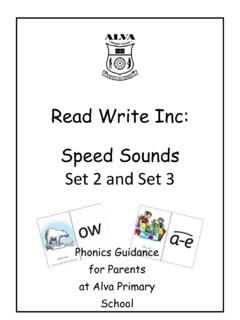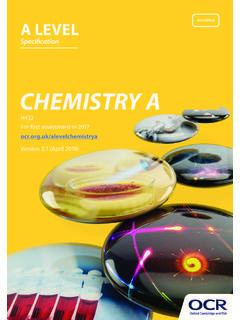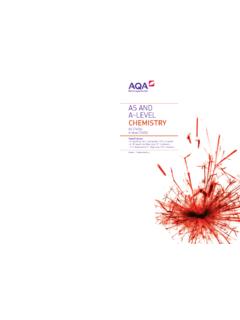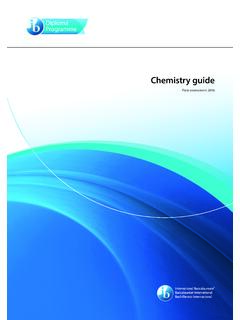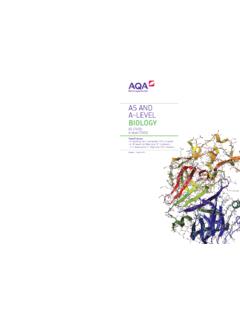Transcription of Advanced Higher Chemistry Past Papers - LT Scotland
1 Advanced Higher Chemistry past Papers October 2020. 1 About this study This document has been designed to make revision and self-marking easy for students studying AH Chemistry in Scotland . The information in this publication has been reproduced to support SQA qualifi- cations only on a noncommercial basis and can only be shared on that condition. 2 How to The following two pages contain tables which cross-reference the course topics with SQA question numbers for the years 2014-19. The first table is for multiple choice questions; the second accesses Section 2. questions. Each question number is hyperlinked to the SQA question and click- ing it will take you there. The question pages have further hyperlinks taking you back to the topic grid (top) or to the SQA marking instructions (bottom). Of course, you can always just treat it as a succession of question Papers with marking instructions. This will be useful for end-of-course timed revision.
2 The SQA Papers are embedded in this document to avoid the problems of broken hyperlinks to web pages that have disappeared. The document is self contained and does not require an internet connection and so is useable anywhere. Mr Sinclair, Vale of Leven Academy 1. Section 1 Qs RAH RAH AH AH AH AH. Unit Topic 2014 2015 2016 2017 2018 2019. EM Radiation and 467 12 1 1 1. Spectra Atomic orbitals and 1235. Inorganic 34 23 1234 235 4. electron config 10. Shape & Polyatomic 89 5 4 4 5. molecules Transition metals 11 6789 5 5 56 678. 7 8 9 10. Chemical Equilibrium 20 21 24 678 67 9 29. 11 12. Physical Reaction Feasibility 22 23 24 9 10 8 13 10 11 12. Kinetics 13 14 25 11 9 10 14 13 14. Molecular Orbitals 15 10 11 18 12 13 11 12 15 15 16. 14 15 16. 18 19 20. 15 16 17 17 18 19 14 15 16 19 20 21. Synthesis 21 22 23 18 19. 26 20 21 22 17 18 22. Organic 24 25. 23. Stereochemistry 16 17 13 14 13 17 17 18. Exp Determination of 26 27 28. 19 25 19 20 23 23 24 25.
3 Structure 29. Drug Interactions 30 21 26. Stoichiometric 26 27 28. 27 30 27 28 29 16 24 27. Calculations 29 30. Researching Gravimetric analysis 30 29 22 28 23. Volumetric analysis 25 27. 23 24 25 25 26 27. Practical skills 28 29 28 29 30. 30 29 30. 2. Section 2 Qs RAH RAH AH AH AH AH. Unit Topic 2014 2015 2016 2017 2018 2019. EM Radiation and 1a 1d 1b 6a 1 1a 4a 4c 7d Spectra Atomic orbitals and Inorganic 1b 1c 1a 4c 23 4aii 1b 10b 1a 4. electron config Shape & Polyatomic 2b molecules 4ai 4bii Transition metals 5 3 4a 6a 6b 4b 6a 2a 6bi 1c 4a 4b Chemical Equilibrium 5 13 6a 5 9bii 2. Physical 6bii 4c Reaction Feasibility 3 2 1 3 4d 1b Kinetics 11a 11b 6b 6b 4bi 4bii 9d 2. Molecular Orbitals 9a 9b 9a 5 7b 7c 689 4a 8 9d 7c 8b 8c 7a 9a 9b 9b 10a Synthesis 9 11c 11c 11d 10 11a 8d 8e 10a 10b 10c Organic Stereochemistry 9a 11d 9c 10 7a 7b 8b 8c 4b 4c 9a 10d Exp Determination of 4e 10e 9b 8a 10 8a 11b 9c 10d 7d 10e Structure 11a 12. Drug Interactions 7a 8a 8d Stoichiometric 1e 2 7b 4bii 6biii 3 6c 7b 3 4c 6.
4 3 4c 4 9bv Calculations 9 12 7a 10a 8a 9b Researching Gravimetric analysis 2 12 4 6biii 3a 3b 6c Volumetric analysis 2 3 4 10a 4 9bi 7c 8b 8c Practical skills 5b 8a 4b 4d 9e 7a 11a 3 7a 7d 9bii 9biv 10c Open-ended Qs 4 10 7 11b 3biii 8f 5 10b 3c 8d 4d 8. 3. X273/13/02. NATIONAL. QUALIFICATIONS. MONDAY, 12 MAY. PM PM. Chemistry . 2014 Advanced Higher . (REVISED). Reference may be made to the Chemistry Higher and Advanced Higher Data Booklet. SECTION A 30 marks Instructions for completion of SECTION A are given on page two. For this section of the examination you must use an HB pencil. SECTION B 70 marks All questions should be attempted. Answers must be written clearly and legibly in ink. SQA *X273/13/02* . Go to Topic Grid 1. The quantum number which specifies the 6. The energy associated with a photon of shape of an orbital is the electromagnetic radiation is A principal quantum number A independent of the frequency B angular momentum quantum number B proportional to the frequency C magnetic quantum number C inversely proportional to the frequency D spin quantum number.
5 D . proportional to the square of the frequency. 2. Element number 104 in the Periodic Table is 7. In absorption spectroscopy, as the A an s-block element concentration of an ion in solution increases, there is an increase in the B a p-block element C a d-block element A wavelength of radiation absorbed D an f-block element. B frequency of radiation absorbed C intensity of radiation absorbed 3. Which of the following statements is D intensity of radiation transmitted. incorrect about electronic configurations of all first row transition metal atoms in their ground states? 8. Which of the following has bond angles equal to 90 ? A The five 3d orbitals are degenerate. A SF6. B They all have at least one electron in the 4s orbital. B NH4+. C Electrons begin to fill the 3d orbitals only C SiCl4. after the 4s orbital is full. D BeF42- D When transition metal atoms form ions, the 4s electrons are lost first. 9. Which of the following does not have a pyramidal structure?
6 4. The colour of a highly concentrated ionic solution which absorbs light only in the ultra- A BF3. violet region of the electromagnetic spectrum B NH3. is C OH3+. A red D PH3. B black C violet 10. The electronic configuration of a vanadium D colourless. atom in its ground state is A ls22s22p63s23p63d5. 5. The Pauli Exclusion Principle states that B ls22s22p63s23p64s2 4p3. A electrons fill degenerate orbitals singly C ls22s22p63s23p63d3 4s2. B electrons fill orbitals in order of D ls22s22p63s23p63d4 4s1 . increasing energy C when degenerate orbitals are half filled all their electrons have parallel spins D no two electrons in the one atom can [Turn over have the same set of four quantum numbers. Go to Answers [X273/13/02] Page three Go to Topic Grid 11. The highest oxidation state of chlorine is 14. A suggested mechanism for the reaction present in 2X + Y X2Y. A HClO. is a two-step process B HClO2. X + Y XY (slow). C HClO3 XY + X X2Y (fast). D HClO4.]
7 This mechanism is consistent with the rate equation, 12. A rate = k[XY]. B rate = k[X][Y]. C rate = k[X]2[Y]. 3. I2 in 50 cm of solvent X D rate = k[X][XY]. I2 in 50 cm3 of solvent Y. 15. The end-on overlap of two atomic orbitals lying along the axis of a bond leads to A hybridisation B a sigma bond Iodine was added to 50 cm3 of two immiscible C a pi bond solvents X and Y as shown. After shaking, the following equilibrium was established. D a double bond. I2(Y) I2(X). An extra 10 cm3 of solvent X was added, 16. Which of the following compounds has a the mixture shaken and equilibrium geometric isomer? re-established. Which of the following statements is correct? A H Cl A The concentration of I2 in Y increases. H C C H. B The concentration of I2 in Y decreases. Cl H. C The equilibrium constant increases. D The equilibrium constant decreases. B H Cl H C C H. 13. The order of a reaction Cl CH3. A can only be obtained by experiment B . determines the speed of the overall C H Cl reaction C C.
8 C . is determined by the stoichiometry H Cl involved D is the sequence of steps in the reaction D H Cl mechanism. C C. Cl H. Go to Answers [X273/13/02] Page four Go to Topic Grid 17. Mandelic acid has two optical isomers X and 20. The formula C4H10O could represent an Y. The table shows the rotation of plane alcohol (C4H9OH) or an ether (C2H5OC2H5). polarised light caused by various solutions of Which of the following statements would not X and Y. be true about both compounds? A . They can be made by nucleophilic Volume of Volume of substitution from a haloalkane. Volume of Observed 0 1mol l 1 0 1 mol l 1. water/cm3 rotation/ B . They have hydrogen bonds between X/cm3 Y/cm3. their molecules. 100 0 0 +158 C They are used as solvents. D They are flammable. 50 0 50 +79. 50 50 0 0. 21. Which of the following will react to form 0 100 0 158 CH3CH2 OCH2CH2CH3? A CH3 CH2OH and CH3CH2 COONa What would be the observed rotation for a B CH3CH2CH2OH and CH3 COONa solution containing 25 cm3 0 1 mol l 1 X and 75 cm3 of 0 1 mol l 1 Y?
9 C CH3CH2 ONa and CH3CH2 CH2I. D CH3CH2 ONa and CH3 CHICH3. A 79 . B 39 5 . C +39 5 22. Which of the following statements is true about the carboxyl group? D +79 . A C O and OH each retain their own properties, unaffected by the other. 18. Which of the following is the formula for a B The properties of the C O are changed tertiary haloalkane? but the OH is unaffected. A CHBr3 C The properties of the OH are changed but the C O is unaffected. B (CH3)3 CBr D . The properties of the C O and the C (CH2Br)3CH OH are each affected by the other. D BrCH2C(CH3)3. 23. One mole of which of the following compounds 19. Propene can be produced by heating will react with the largest volume of 1 mol l-1. 1-bromopropane with ethanolic potassium CH3 NHCH. hydrochloric acid? 3. hydroxide. A CH. H3 NHCH. NCH3 NH. This reaction is an example of 2 2 2. B H2 NCH2NH2. A reduction HOOCCH NH2. C HOOCCH2NH22. B hydrolysis C elimination D HO. HOOC NH2. NH. 2. D condensation.
10 [Turn over Go to Answers [X273/13/02] Page five Go to Topic Grid 24. Which of the following structures represents a 26. A simplified mass spectrum of an organic tertiary amine? compound is shown below. H CH3 H. 100. A H C N C H. 80. Percentage intensity H H. 60. H H H. 40. B H C N C H. H H 20. 0. H H H. 10 15 20 25 30 35 40 45 50 55 60. C H C C C H m/z Which of the following compounds produces H NH2 H. this spectrum? H H H A Propane D H C C C H B Propan-1-ol C Propan-2-ol NH2 NH2 NH2. D Propanone 25. Which of the following is not an example of a hydrolysis reaction? 27. Which of the following analytical techniques depends on the vibrations within molecules? A C2H4 + H2O C2H5OH. A Nuclear magnetic resonance spectroscopy B CH3CN + 2H2O CH3 COOH + NH3. B Atomic emission spectroscopy C CH3 COOCH3 + H2O CH3 COOH + CH3OH. C Infra-red spectroscopy D C6H5 COOCH3 + H2O C6H5 COOH + CH3OH. D Mass spectrometry 28. The two isotopes of bromine have mass numbers of 79 and 81.]



